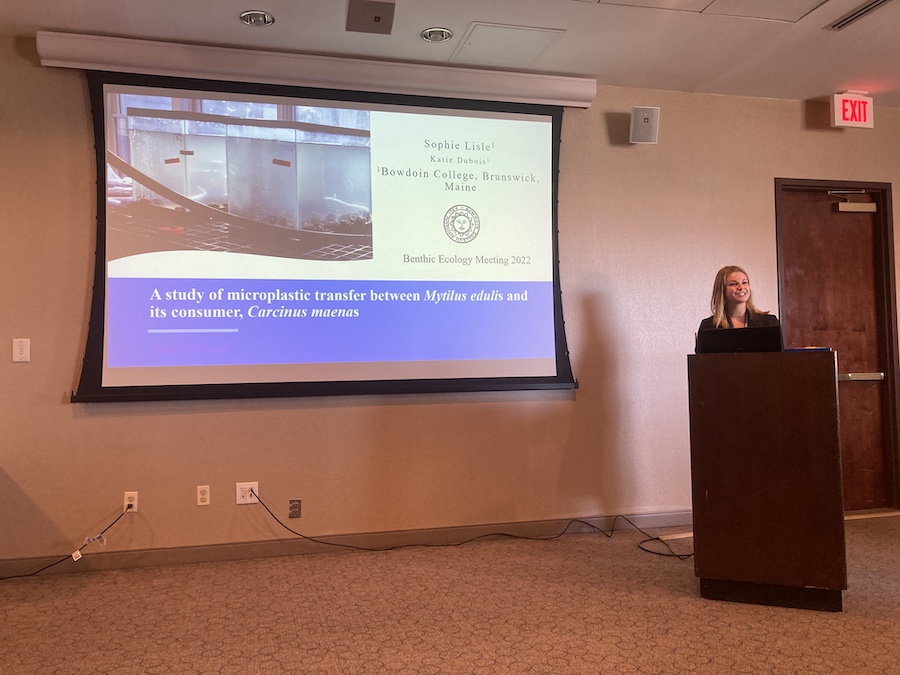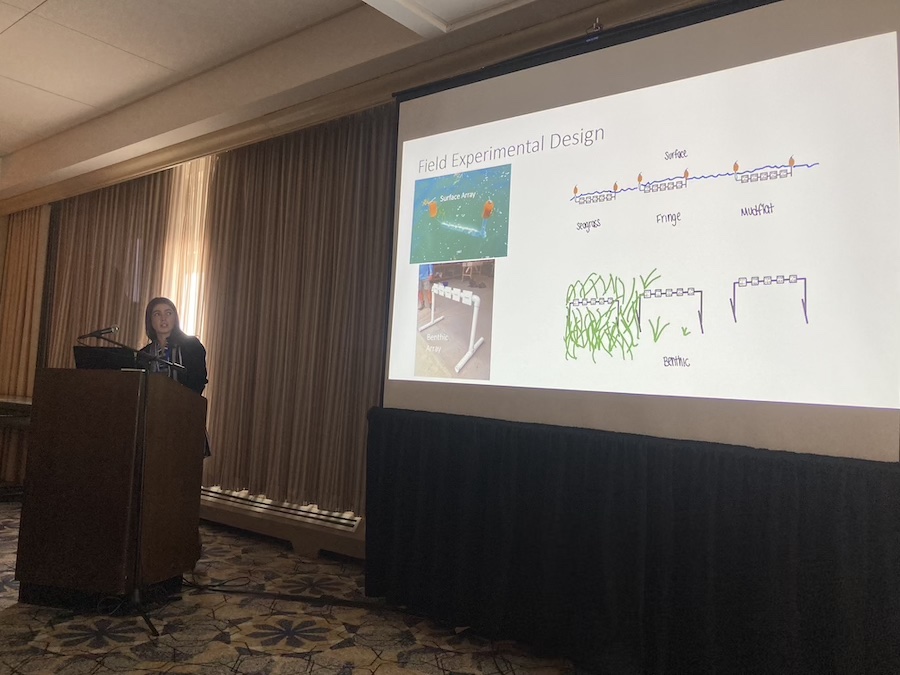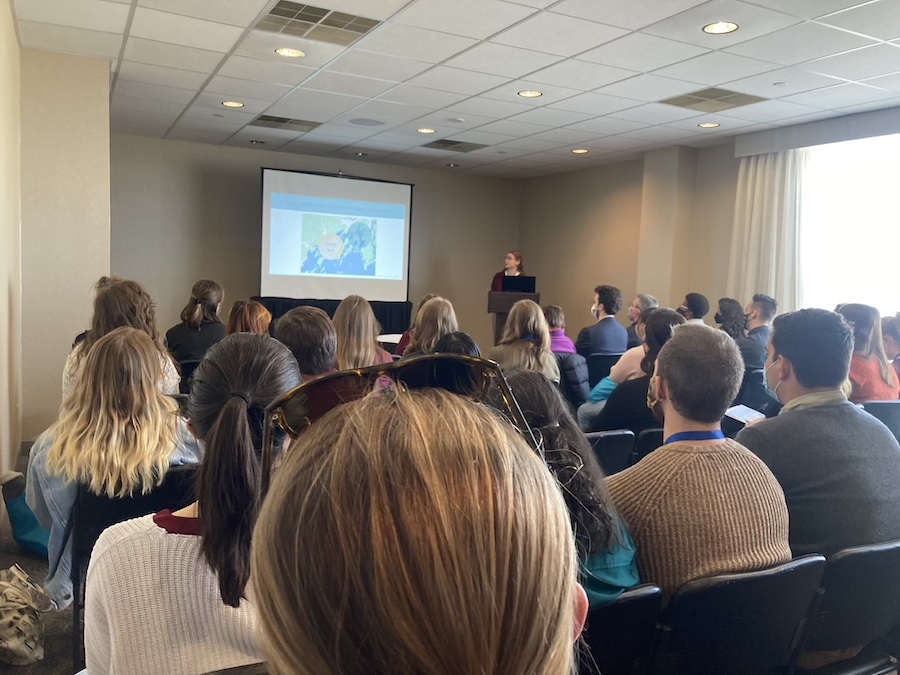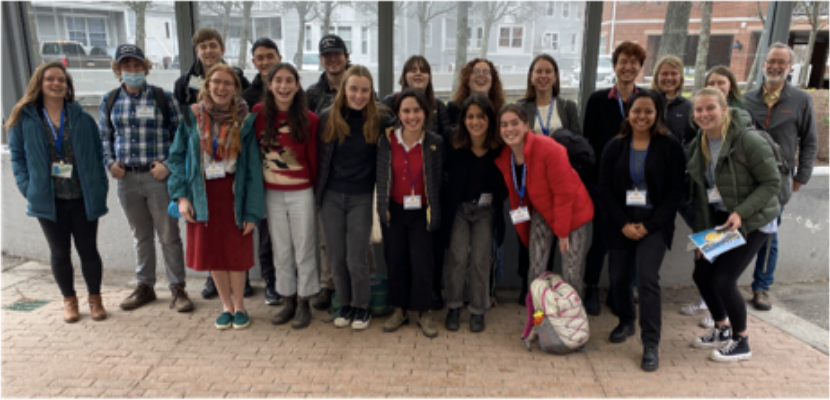Large Cohort of Students Present Research at National Ecology Conference
By Rebecca Goldfine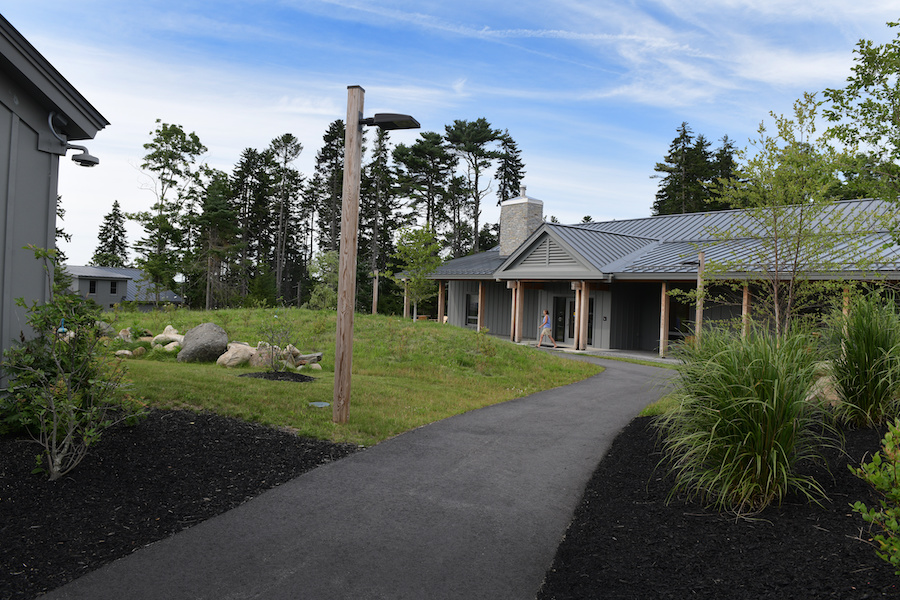
Scientists from around the country descended on the small New Hampshire city from March 29 to April 2 to attend the annual conference on marine benthic ecology, or the study of different ecosystems on the ocean floor.
The Bowdoin contingent was the largest student group the College has ever sent to the conference to give talks or share posters. Katie DuBois ’11, Bowdoin's Doherty Marine Biology Postdoctoral Scholar, said the expanded facilities at the Schiller Center played a role in their achievement, as this was the first year that Bowdoin-funded summer research fellows and Bowdoin Marine Science Semester students were able to use the new lab space and other amenities.
"The quality of research completed by Bowdoin students at the center over the last nine months speaks to how incredible the new facilities are and how Bowdoin's marine science program is continuing to expand," she said. "The research projects many students are conducting are on par with graduate-level research and contributing important knowledge to the field of marine ecological research and human impacts on coastlines."
Getting the chance to share their own research at a professional conference is an important experience for early-career scientists, DuBois added. "Most students do not have this experience until graduate school, and for Bowdoin students to have the opportunity now means that they are better networked within the scientific community and prepared for careers after graduation," she said.
Sophia Lisle ’23, whose talk addressed the impacts of plastic pollution on blue mussels, said the experience gave her a confidence boost. "It was empowering to meet so many marine science experts at the Benthic Ecology Meeting and share what I have been learning in my microplastic studies with these scientists," she said.
In addition to the speakers, students from Dave Carlon's class Research Methods in Ecology, Evolution, and Marine Biology attended the conference. (Four of the presenters are also students in his class.) The speakers were mentored by Bowdoin faculty members Katie Dubois, Dave Carlon, and Justin Baumann.

Sophia Adami-Sampson ’24
"Microplastics are ubiquitous in farmed Eastern oysters (Crassostrea virginica) from Casco Bay, Maine"
Adami-Sampson compared microplastic concentrations in oysters grown in nine farms in Casco Bay to identify variation in pollution levels among farms and topographical regions. Some of the farms were located in sheltered inlets and others in an open bay area, but she found plastics in similar concentrations across the region. "Mine is the first study to quantify microplastics in farmed oysters from the East Coast, so direct comparison to other locations is challenging. However, with approximately 6.25 microplastics per oyster, pollution in Casco Bay farmed oysters is similar to that in wild harvested Eastern oysters and farmed Pacific oysters from the West Coast," she said.
But Adami-Sampson put her findings in context: Though microplastics are ubiquitous in oysters grown for human consumption, microplastics have also been identified in meat, vegetables, and drinking water. "With that in mind, I believe we should continue to support the environmentally conscious oyster farmers of Casco Bay that made my work possible," she said.
“I was grateful for the opportunity to study human impacts on ecology at the Schiller Coastal Studies Center, where the organisms of interest are both highly accessible and relevant to the surrounding community. This project laid a strong foundation for my future research, which I hope will investigate human impacts and disturbance ecology in other ecosystems, whether marine or terrestrial.”
—Sophia Adami-Sampson ’24

Jared Lynch ’24
"An application of RNAseq to characterize links between mitochondrial genotype and ecological phenotype in the European green crab (Carcinus maenas)"

Olivia Bronzo-Munich ’23
"Investigating interpopulation variation in induced defense in the macroalgae Fucus vesiculosus under thermal stress"
Bronzo-Munich investigated the vulnerability of bladderwrack (Fucus vesiculosus), an important seaweed in the Gulf of Maine intertidal, to the increased water temperatures expected with climate change. She performed a feeding assay and thermal ramping experiment to see if populations from near Bowdoin and those farther north along Maine's coast are equally able to grow, defend themselves against herbivory, and photosynthesize while under warming stress. "Overall, I found optimum photosynthesis at temperatures far above those predicted for the future and no evidence of regional local adaptation to temperature. Both findings bode well for bladderwrack facing climate change in the Gulf of Maine," she concluded.
“I was excited by the opportunity provided by the Bowdoin Marine Science Semester to design, carry out, and present my research. I loved the chance to work on questions related to adaptation, herbivory, and climate change while getting to know the Gulf of Maine intertidal.”
—Olivia Bronzo-Munich ’23
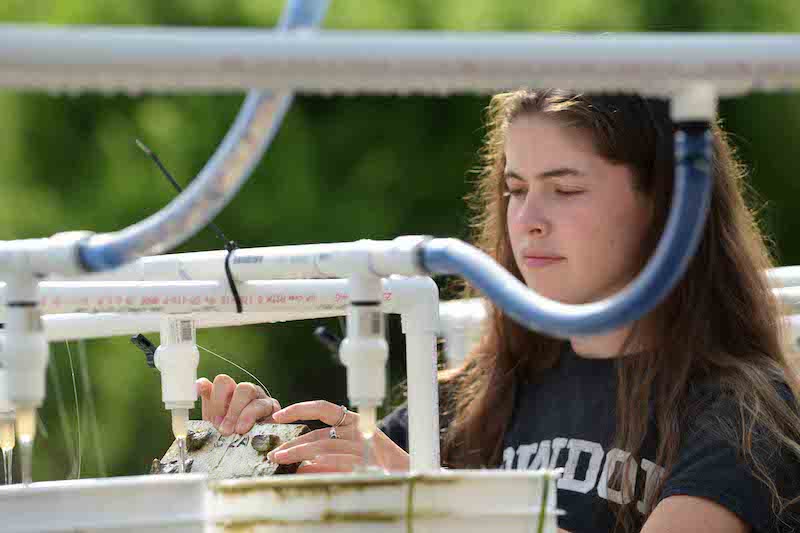
Fiona Ralph ’22
"Mitigation of negative effects of ocean change on oysters by eelgrass and its implications for aquaculture in midcoast Maine"
As the ocean absorbs more carbon dioxide from burning fossil fuels, it is growing increasingly acidic, preventing calcifying organisms, like oysters and other mollusks, from constructing shells. Ralph investigated a possible mitigating solution that could help midcoast Maine oyster farmers avoid the economic fallout from ocean acidification on their crops. She looked at Zostera marina, or eel grass—a common marine macrophyte—to investigate whether its photosynthetic capabilities could ameliorate the low pH in water near growing oysters. Results from her experiment—on which she collaborated with other students and researchers at the Schiller Coastal Studies Center—show that the oysters grown within eel grass meadows or adjacent to them on the ocean floor develop larger shells. "These findings could call into question the current practices of oyster farming, especially as ocean acidification continues," Ralph said. Read more about this experiment.
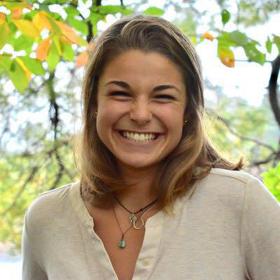
Sophia Lisle ’23
"Increasing water column microplastic concentrations causes increased plastic consumption across trophic levels: Mytilus edulis and its consumer, Carcinus maenas"
As a biology and pre-veterinarian student, Lisle said she's fascinated by the intersections between animal physiology and the environment, such as the impact of plastic pollution on individual organisms and on a larger ecosystem. For her research project, Lisle "explored how much oceanic microplastic accumulates in higher-level trophic species by testing the transfer of microplastic beads from seawater to blue mussels to the green crabs" that eat mussels. She found that mussels, which filter seawater, are more susceptible to harm from high microplastic concentrations than their invasive predator, the green crab. "This finding has important implications for rapidly declining blue mussel populations in the Gulf of Maine," she concluded.

Deva Holliman ’23
"Evidence of local adaptation in the temperate coral Astrangia poculata"
In the face of global coral reef decline, many scientists are studying the tolerance of corals to warming oceans. Recent research has shown that corals acclimated to higher temperatures may demonstrate greater resiliency. In her study, Holliman sourced Astrangia poculata colonies (also known as northern star coral) from populations in both North Carolina and Rhode Island to see whether short-term acclimation (twenty-one days) to elevated seawater temperatures impacted their cellular respiration, photosynthesis, fluorescence, and calcification. She found strong evidence of a thermal optimum for the Rhode Island population at 22°C, and that optimal temperatures for the North Carolina population may be more than 25°C. Furthermore, she demonstrated differences in rates of photosynthesis and fluorescence between the two populations, revealing potential local adaptation to the light conditions of the corals’ native environments.

Sam Neirink ’22, Briget Patterson ’23, and Nicky Yoong ’24 presented their research at a poster symposium. (Eban Charles ’23 and Kellie Navarro ’23 were also invited but couldn't attend.) Yoong received an award for best poster presentation.
The following are the titles of their projects:
Patterson: "Feeding preferences and ocean warming interactively effect the growth rates of Idotea balthica"
Neirink: "Green crab predation, blue mussel disappearance, and the rocky intertidal"
Yoong: "The effect of salinity and conspecific odor on molting of field-caught Uca spp. megalopae"
Charles: "Non-consumptive effects of black sea bass (Centropristis striata) on juvenile American lobster (Homarus americanus) in a changing climate"
Navarro: "Gene expression of symbiotic northern star coral (Astrangia poculata) in response to acute cold stress"
